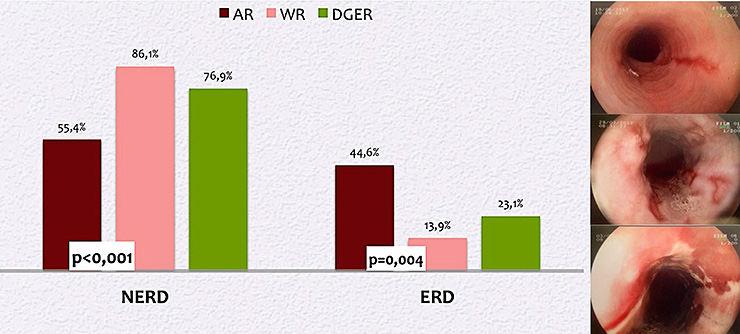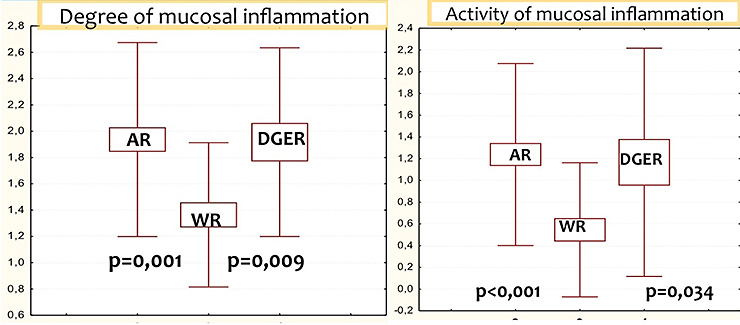Role of acid and non-acid reflux esophageal mucosal damage (erosive esophagitis and Barrett's esophagus)
Авторы: Кайбышева В.О. / Трухманов А.С. / Пономарев А.Б. / Сторонова О.А. / Коньков М.Ю. / Ивашкин В.Т.
Valeria Kaibysheva*, Alexander Trukhmanov, Andrey Ponomarev, Olga Storonova, Mikhail Konkov, Vladimir Ivashkin
First Moscow state medical university, Moscow, Russian Federation
Aims & Methods:The aim of this study was to access the role of acid (pH<4), weakly-acid (4<pH<7) and alkaline (pH>7) reflux in esophageal mucosal injury.
127 patients (75(59.1%) women and 52(40.9%) men, averaging 48.6 ± 14.9 years), off acid-suppressive therapy underwent upper-GI endoscopy with biopsy and combined esophageal pH-impedance monitoring.
According to data from pH-impedance study patients were subdivided into three groups by predominant characteristic of reflux: GERD with acid reflux (n = 65; AR); GERD with weakly-acid reflux (n = 36, WR); GERD with duodenogastroesophageal reflux (n = 26, DGER).
Results:Catarrhal esophagitis (NERD) was found during endoscopy in 55.4% AR group, in 86.1% WR group, and in 76.9% DGER group,(p (AR-WR) <0.05).
Erosive esophagitis (ERD) was found in 40%, 13.9% and 23.1% for AR, WR, DGER, respectively (p (AR-WR) <0,05). Esophageal ulcers were found only in AR group in 4.6%.

Fig. I. Results of upper-GI endoscopy in GERD patients with different types of reflux
AR and DGER patients had significantly higher activity and degree of mucosal inflammation than patients in WR group (p<0,05).

Fig. II. Activity and degree of mucosal inflammation in GERD patients with different types of reflux
Endoscopic changes indicating Barrett's esophagus with histologic presence of esophageal intestinal metaplasia was found in 16%, 5.8%, and 42.9% for AR, WR, DGER, respectively (pAR-DGER<0,05; pWR-DGER<0,05).

Fig. III. Endoscopic changes indicating Barrett's esophagus with histologic presence of esophageal intestinal metaplasia in DGER patient

Fig. IV. Results of histological study in GERD patients with different types of reflux
Conclusion:
- Acid reflux is the key factor in causing esophageal injury, sue as esophageal erosions and ulcers.
- Weakly acidic reflux does not contribute significantly to esophageal mucosal damage, but may cause catarrhal esophagitis.
- Duodenogastroesophageal reflux plays an important role in developing Barrett's esophagus.
*Copyright©2014KaibyshevaV.O.valeriakai@mail.ru